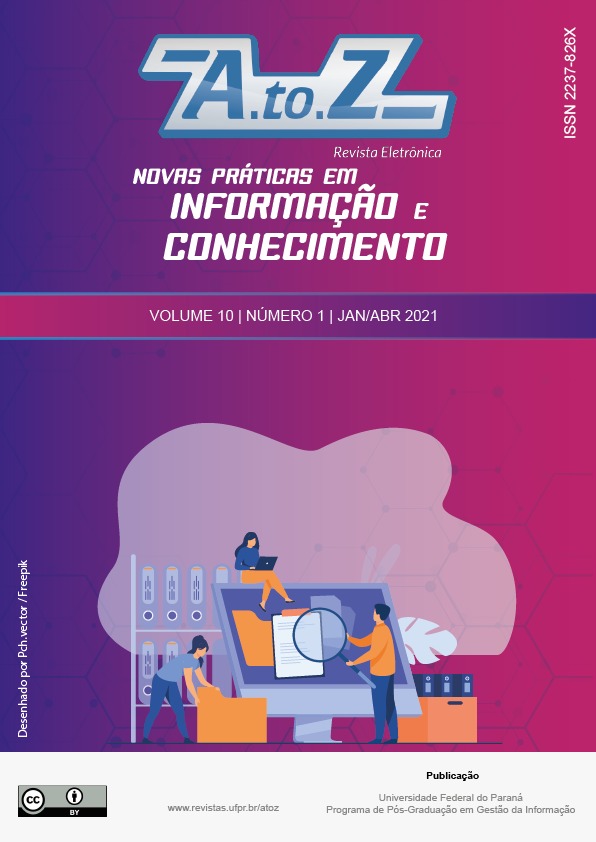Técnicas de elicitação de requisitos no desenvolvimento de software: uma revisão sistemática da literatura
DOI:
https://doi.org/10.5380/atoz.v10i1.77393Palavras-chave:
Elicitação de requisitos, Sistemas de informação, Participação da equipe.Resumo
Introdução: A elicitação de requisitos (ER) é uma tarefa difícil na qual é necessário lidar com ambiguidade de informações, dados incompletos e inconsistentes. Ela busca descobrir e entender o real problema e as necessidades dos usuários. O sucesso do desenvolvimento de software depende da elicitação correta dos requisitos, e a qualidade deles é influenciada pelas técnicas usadas. Dentro deste contexto, o objetivo desta pesquisa é identificar as técnicas de ER mais citadas na literatura em projetos de desenvolvimento de software. Método: Foi realizada uma revisão sistemática da literatura, que analisou 61 artigos da base de dados Scopus. Resultados: Foram identificadas as 10 técnicas de ER mais citadas na literatura. A classificação dessas técnicas mostrou que aquelas obtidas pelo envolvimento de grupos de stakeholders foram as menos citadas. Conclusão: A pesquisa identificou a oportunidade e relevância para o desenvolvimento de pesquisa acadêmica descritiva ou confirmatória sobre técnicas de ER baseadas na interação entre grupos de usuários e membros da equipe de desenvolvimento de software.
Referências
Abd-Elmonem, M., Nasr, E., & Gheith, M. (2018). Automating Requirements Elicitation of Cloud-Based ERPs. Proceedings Of The International Conference On Advanced Intelligent Systems And Informatics 2017, 171-180. Springer International Publishing. doi: 10.1007/978-3-319-64861-3_16
Adem, N. & Kasirun, Z. (2010). Automating function points analysis based on functional and non-functional requirements text. The 2nd International Conference on Computer and Automation Engineering (ICCAE), 664–669. IEEE. doi: 10.1109/ICCAE.2010.5451322.
Al-Qudah, D., Cristea, A., & Lei, S. (2013). An exploratory study to design an adaptive hypermedia system for online advertisement. The 9th International Conference on Web Information Systems and Technologies, 368–374. doi: 10.13140/2.1.3107.9368
Alexa, L. & Avasilcai, S. (2018). The requirement elicitation process of designing a collaborative environment – the cre@tive.biz case. MATEC Web Conf, 184(2018), 1-4. doi: 10.1051/matecconf/201818404010.
Alvertis, I., Papaspyros, D., Koussouris, S., Mouzakitis, S., & Askounis, D. (2016). Using crowdsourced and anonymized personas in the requirements elicitation and software development phases of software engineering. 2016 11th International Conference on Availability, Reliability and Security (ARES), 851–856. IEEE. doi: 10.1109/ARES.2016.71.
Angelis, G., Ferrari, A., Gnesi, S., & Polini, A. (2018). Requirements elicitation and refinement in collaborative research projects. Journal of Software: Evolution and Process, 30(12), 1–18. John Wiley and Sons Ltd. doi: 10.1002/smr.1990.
Araujo, R., Anjos, E., & Silva, D. (2015). Trends in the use of design thinking for embedded systems. 15th International Conference on Computational Science and Its Applications, 82–86. doi: 10.1109/ICCSA.2015.25.
Asghar, A., Tabassum, A., Bhatti, S., & Jadi, A. (2017). Impact and challenges of requirements elicitation prioritization in quality to agile process: Scrum as a case scenario. 2017 International Conference on Communication Technologies (ComTech), 50–55. IEEE. doi: 10.1109/COMTECH.2017.8065749.
Babar, A., Bunker, D., & Gill, A. (2018). Investigating the relationship between business analyst’s competency and is requirements elicitation: A thematic analysis approach. Communications Of The Association For Information Systems, 42(1), 334–362. Association for Information Systems. doi: 10.17705/1CAIS.04212.
Baptista, M. N., & Campos, D. C. d. (2017). Metodologias de pesquisa em Ciências Análise Quantitativa e Qualitativa (2a ed.). Rio de Janeiro: LTC.
Batista, E. A. (2003). Uma taxonomia facetada para técnicas de elicitação de requisitos (Dissertação de Mestrado), Instituto de Computação, UNICAMP, Campinas, SP, Brasil. Recuperado de: http://repositorio.unicamp.br/bitstream/REPOSIP/276373/1/Batista_EdinelsonAparecido_M.pdf
Batool, A., Motla, Y., Hamid, B., Asghar, S., Riaz, M., Mukhtar, M., & Ahmed, M. (2013). Comparative study of traditional requirement engineering and agile requirement engineering. International Conference on Advanced Communication Technology, ICACT, 1006–1014. IEEE
Buitron, S. L., Flores-Rios, B. L., & Pino, F. J. (2018). Elicitación de requisitos no funcionales basada en la gestión de conocimiento de los stakeholders. Ingeniare: Revista Chilena de Ingeniería, 26(1), 142–156. Scielo. doi: 10.4067/S0718-33052018000100142.
Caleb-Solly, P., Dogramadzi, S., Ellender, D., Fear, T., & Van Den Heuvel, H. (2014). A mixed-method approach to evoke creative and holistic thinking about robots in a home environment. ACM/IEEE International Conference on Human-Robot Interaction, 374–381. ACM Press. doi: 10.1145/2559636.2559681.
Cervo, A. L., Bervian, P. A. & Silva, R. (2007). Metodologia científica (6a ed.). São Paulo: Pearson Prentice Hall.
Fernandes, J., Duarte, D., Ribeiro, C., Farinha, C., Pereira, J., & Da Silva, M. (2012). Ithink: a game-based approach towards improving collaboration and participation in requirement elicitation. Procedia Computer Science, 15(1), 66–77, Genoa: Elsevier B.V. doi: 10.1016/j.procs.2012.10.059.
Gill, K., Zaidi, A., & Kiani, M. (2014). Eliciting futuristic end-user requirements through contributory appreciative inquiry. 2014 National Software Engineering Conference, Rawalpindi, 49–54. IEEE. doi: 10.1109/NSEC.2014.6998240.
Gonzales, C. K., & Leroy, G. (2011). Eliciting user requirements using appreciative inquiry. Empirical Software Engineering, 16(6), 733–772. doi: 10.1007/s10664-011-9156-x.
Hajri, I., Goknil, A., Briand, L., & Stephany, T. (2018). Configuring use case models in product families. Software & Systems Modeling, 17(3), 939–971. Springer Verlag. doi: 10.1007/s10270-016-0539-8.
Hickey, A. & Davis, A. (2003). Elicitation technique selection: How do experts do it? Proceedings of the 11th IEEE International Conference on Requirements Engineering, 169–178. IEEE. doi: 10.1109/ICRE.2003.1232748.
Hidalga, A., Hardisty, A., & Jones, A. (2016). Scram–ck: applying a collaborative requirement engineering process for designing a web-based e-science toolkit. Requirements Engineering, 21(1), 107–129. Springer-Verlag London Ltd. doi: 10.1007/s00766-014-0212-0.
Hosseini, M., Shahri, A., Phalp, K., Taylor, J., Ali, R., & Dalpiaz, F. (2015). Configuring crowdsourcing for requirements elicitation. 2015 IEEE 9Th International Conference On Research Challenges In Information Science (Rcis), 133–138. IEEE Computer Society. doi: 10.1109/RCIS.2015.7128873.
Jayatilleke, S., & Lai, R. (2018). A systematic review of requirements changes management. Information and Software Technology, 93(1), 163–185. Elsevier B.V. doi: 10.1016/j.infsof.2017.09.004.
Kitchenham, B. (2004). Procedures for performing systematic reviews. Keele University. Technical Report, Department of Computer Science, Keele University, UK.
Kitchenham, B., & Charters, S. (2007). Guidelines for performing systematic literature reviews in software engineering. Technical Report EBSE 2007-001, Keele University and Durham University Joint Report.
Knauss, E., Yussuf, A., Blincoe, K., Damian, D., & Knauss, A. (2018). Continuous clarification and emergent requirements flows in open-commercial software ecosystems. Requirements Engineering, 23(1), 97–117. Springer London. doi: 10.1007/s00766-016-0259-1.
Li, H., Li, X., Hao, J., Xu, G., Feng, Z., & Xie, X. (2017). FESR: A framework for eliciting security requirements based on integration of common criteria and weakness detection formal model. 2017 IEEE International Conference On Software Quality, Reliability And Security (Qrs), 352–363. IEEE. doi: 10.1109/QRS.2017.45.
Maria, H. & Ali, Z. (2018). Requirement elicitation techniques for open source systems: a review. International Journal of Advanced Computer Science and Applications (IJACSA), 9(1), 330-334. doi: 10.14569/IJACSA.2018.090145
Mishra, D., Aydin, S., Mishra, A., & Ostrovska, S. (2018). Knowledge management in requirement elicitation: Situational methods view. Computer Standards & Interfaces, 56(1), 49–61. Elsevier B.V. doi: 10.1016/j.csi.2017.09.004
Mishra, D., Mishra, A., & Yazici, A. (2008). Successful requirement elicitation by combining requirement engineering techniques. 2008 First International Conference on the Applications of Digital Information and Web Technologies (ICADIWT), 258–263. IEEE. doi: 10.1109/ICADIWT.2008.4664355
Mobasher, B. & Clelandhuang, J. (2011). Recommender systems in requirements engineering. AI Magazine, 32(3), 81-89. Association for the Advancement of Artificial Intelligence (AAAI). doi: 10.1609/aimag.v32i3.2366.
Nuseibeh, B. & Easterbrook, S. (2000). Requirements engineering: a roadmap. Proceedings of the Conference on The Future of Software Engineering, 35–46. ACM. doi: 10.1145/336512.336523.
Odusote, B., Daramola, O., & Adigun, M. (2018). Towards an extended misuse case framework for elicitation of cloud dependability requirements. SAICSIT '18 Proceedings of the Annual Conference of the South African Institute of Computer Scientists and Information Technologists, 135–144. ACM. doi: 10.1145/3278681.3278698.
Ohashi, K., Katayama, A., Hasegawa, N., Kurihara, H., Yamamoto, R., Doerr, J., & Magin, D. (2018). Focusing requirements elicitation by using a UX measurement method. IEEE 26th International Requirements Engineering Conference (RE), 347–357. IEEE. doi: 10.1109/RE.2018.00-26.
Oriol, M., Stade, M., Fotrousi, F., Nadal, S., Varga, J., Seyff, N., Abello, A., Franch, X., Marco, J., & Schmidt, O. (2018). Fame: supporting continuous requirement elicitation by combining user feedback and monitoring. 2018 IEEE 26th International Requirements Engineering Conference (RE), 217–227. IEEE doi: 10.1109/RE.2018.00030.
Pandey, D., Suman, U., & Ramani, A. (2010). An effective requirement engineering process model for software development and requirements management. 2010 International Conference on Advances in Recent Technologies in Communication and Computing, 287 – 291. doi: 10.1109/ARTCom.2010.24
Pitula, K. & Radhakrishnan, T. (2011). On eliciting requirements from end-users in the ICT4D domain. Requirements Engineering, 16(1), 323–351. Springer. doi: 10.1007/s00766-011-0127-y.
Ramakrishnan, L., Poon, S., Hendrix, V., Gunter, D., Pastorello, G., & Agarwal, D. (2014). Experiences with user-centered design for the tigers workflow API. 2014 IEEE 10Th International Conference On E-Science, 290–297. IEEE. doi: 10.1109/eScience.2014.56.
Ramesh, R. M., & Reddy, S. C. (2016). A survey on security requirement elicitation methods: classification, merits, and demerits. International Journal of Applied Engineering Research, 11(1) 64–70.
Romero, M., Vizcaíno, A., & Piattini, M. (2009). Teaching requirements elicitation within the context of global software development. In 2009 Mexican International Conference on Computer Science, 232–239. doi: 10.1109/ENC.2009.29.
Sadiq, M., Ghafir, S., & Shahid, M. (2009). An approach for eliciting software requirements and its prioritization using analytic hierarchy process. 2009 International Conference on Advances in Recent Technologies in Communication and Computing, 790–795. IEEE. doi: 10.1109/ARTCom.2009.58.
Seyff, N., Graf, F., & Maiden, N. (2010). Using mobile re tools to give end-users their own voice. 2010 18th IEEE International Requirements Engineering Conference, 37–46. IEEE. doi: 10.1109/RE.2010.15.
Seyff, N., Todoran, I., Caluser, K., Singer, L., & Glinz, M. (2015). Using popular social network sites to support requirements elicitation, prioritization, and negotiation. Journal of Internet Services and Applications, 6(1), 1-16. Springer Science and Business Media LLC. doi: 10.1186/s13174-015-0021-9.
Sheffield, J., & Lemetayer, J. (2013). Factors associated with the software development agility of successful projects. International Journal of Project Management, 31(1), 459–472. Elsevier. doi: 10.1016/j.ijproman.2012.09.011
Smith, C., Strauss, J., & Maher, P. (2010). Data structure visualization: the design and implementation of an animation tool. Proceedings of the 48th Annual Southeast Regional Conference, 1-6. ACM. doi: 10.1145/1900008.1900105.
Thomas, K., Bandara, A., Price, B., & Nuseibeh, B. (2014). Distilling privacy requirements for mobile applications. ICSE 2014: Proceedings of the 36th International Conference on Software Engineering, 871–882. ACM. doi: 10.1145/2568225.2568240.
Vijayan, J., Raju, G., & Joseph, M. (2016). Collaborative requirements elicitation using elicitation tool for small projects. 2016 International Conference on Signal Processing, Communication, Power and Embedded System (SCOPES), 340–344. doi: 10.1145/10.1109/SCOPES.2016.7955848.
Wertsch, J. V. (1981). The concept of activity in soviet psychology: an introduction. In J. V. Wertsch (ed.). The Concept of Activity in Soviet Psychology. Armonk: M.E. Sharpe.
Wohlrab, R., De Gooijer, T., Koziolek, A., & Becker, S. (2014). Experience of pragmatically combining RE methods for performance requirements in industry. 2014 IEEE 22nd International Requirements Engineering Conference (RE), 344–353. IEEE. doi: 10.1109/RE.2014.6912285.
Younas, M., Jawawi, D., Ghani, I., & Kazmi, R. (2017). Non-functional requirements elicitation guideline for agile methods. Journal of Telecommunication, Electronic and Computer Engineering, 9(1), 137–142. University Teknikal Malaysia Melaka.
Downloads
Publicado
Como Citar
Edição
Seção
Licença
A revista AtoZ é um periódico científico de acesso aberto e o copyright dos artigos e da entrevista pertence aos respectivos autores/entrevistados com cessão de direitos para a AtoZ no que diz respeito à inclusão do material publicado (revisado por pares/postprint) em sistemas/ferramentas de indexação, agregadores ou curadores de conteúdo.

Todo o conteúdo da Revista (incluindo-se instruções, política editorial e modelos) está sob uma licença Creative Commons Atribuição 4.0 Não Adaptada, a partir de Outubro de 2020.
Ao serem publicados por esta Revista, os artigos são de livre uso para compartilhar (copiar e redistribuir o material em qualquer suporte ou formato para qualquer fim, mesmo que comercial) e adaptar (remixar, transformar, e criar a partir do material para qualquer fim, mesmo que comercial). É preciso dar o crédito apropriado , prover um link para a licença e indicar se mudanças foram feitas .
A AtoZ não cobra qualquer tipo de taxa para submissão e/ou processamento e/ou publicação de artigos.


























